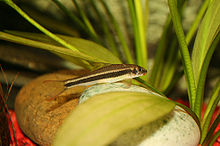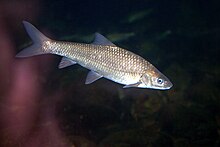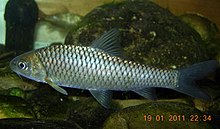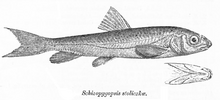Carp fish
| Carp fish | ||||||||||||
|---|---|---|---|---|---|---|---|---|---|---|---|---|

Bartellos line barbel ( Striuntius lineatus ) |
||||||||||||
| Systematics | ||||||||||||
|
||||||||||||
| Scientific name | ||||||||||||
| Cyprinidae | ||||||||||||
| Rafinesque , 1810 |
The carp fish (Cyprinidae) are the largest family of the carp-like (Cypriniformes). The family includes well-known freshwater fish such as the carp , the crucian carp , the gable and its cultivated form, the goldfish , many small species that are suitable as aquarium fish, and with gate from the Indian subcontinent and the Southeast Asian giant mullet ( Catlocarpio siamensis ) also the largest carp fish species in the world.
With over 1300 species, the carp fish are the most species-rich family of carp-like species (approx. 4300 species) and with around 400 closely related species they contain more polyploid (approx. 100 tetraploid and approx. 150 hexaploid) species than any other fish group. These species are likely due to hybridization of different original species and a subsequent rapid adaptive radiation . Most species of carp fish are found in waters of southern Eurasia and Africa, others also in northern and central Europe or in central Asia. The carp and other species that are important for human nutrition were distributed almost worldwide by humans and now also live in the waters of regions that were previously free from carp fish, such as South America, Madagascar, Australia and New Zealand.
features
The carp family includes quite small (only 3 cm in length), but also very large (2 m) species. Your body is elongated to high back and only slightly flattened on the sides. The mouth is terminal or subordinate. The lips are thick, fleshy and often covered with structures such as tubercles, papillae or fringe-like protrusions. Barbels may be absent or present with a pair or two. The jaws are toothless; on the pharynx there are, however, fused pharyngeal teeth that can be used to determine the species. The pharynx teeth stand in one, two or three rows and are usually moved against a horn plate on the underside of the skull, the so-called carp or millstone. The structure of the mouth is characteristic of the individual genera and an important taxonomic feature. Furthermore, the carp-like do not have a developed stomach, the esophagus goes directly into the midgut. The swim bladder consists of two or more parts and is connected to the inner ear via a series of eight small bones ( Weber's apparatus ), so that sound wave transmission is possible. Another characteristic of the carp fish is the spawning rash and the deterrent (alarm substance in special skin cells) that warns schooling fish if one of them has been grabbed by a predator (pike, heron).
The dorsal fin usually sits directly above the pelvic fins . The first rays of the dorsal and anal fin are ossified and undivided. The rear edge of the first fin ray can be serrated. The short anal fin has five to seven divided soft rays.
Systematics
|
Phylogenetic systematics of carp fish according to Yang et al. 2015
|
The carp fish were introduced as a taxon in 1810 by the American polymath Constantine S. Rafinesque-Schmaltz . Up until the mid-2010s, they included numerous subfamilies that are now independent families (e.g. whitefish , danishes , etc.), but now only include the former Cyprininae. These were systematically revised in 2015 by Jörg Freyhof and colleagues and divided into eleven tribes . In the scientific fish database Catalog of Fishes, the system of which is reproduced here, the 11 tribes have become 10 subfamilies, since the Poropuntiini in the Catalog of Fishes are placed with the Cyprinini, here Cyprininae.

- Probarbinae Yang et al., 2015; South East Asia
-
Labeoninae Bleeker, 1859; Africa and tropical Asia
- Labeo and about 40 other genera
- Torinae Karaman, 1971; Africa and tropical Asia
- Barbopsis
- Naziritor
- Neolissochilus
- goal
- Hypselobarbus clade
- Labeobarbus clade
- Smiliogastrinae Bleeker, 1863; Africa and tropical Asia
 Oreichhys parvus , male
Oreichhys parvus , male - Cyprininae Rafinesque, 1815; EurasiaShark teal ( Balantiocheilos melanopterus )
 Common carp ( Cyprinus carpio )
Common carp ( Cyprinus carpio ) Wetmors barbel ( Hypsibarbus wetmorei )
Wetmors barbel ( Hypsibarbus wetmorei )- Aaptosyax
- Albulichthys
- Amblyrhynchichthys
- Balantiocheilos
- 'Barbodes' semifasciolatus
- Bar bonymus
- 'Barbonymus' gonionotus
- Carassioides
- Carassius
- Cosmochilus
- Cyclocheilichthys
- Cyclocheilos
- Cyprinus
- Discherodontus
- Eirmotus
- Hypsibarbus
- Kalimantania
- Laocypris
- Luciocyprinus
- Mystacoleucus
- Neobarynotus
- Parasikukia
- Paraspinibarbus
- Parator
- Poropuntius
- Procypris
- Puntioplites
- 'Puntius' snyderi
- Rohteichthys
- Sawbwa
- Scaphognathops
- Sikukia
- Sinocyclocheilus
- Typhlobarbus
- Acrossocheilinae Yang et al., 2015; Southeast Asia and China
- Spinibarbinae Yang et al., 2015; Laos, northern Vietnam and southern China
- Schizothoracinae McClelland, 1842; Central Asia
- Schizopygopsinae Mirza, 1991; Central Asia
- Barbinae Bleeker, 1859; Eurasia, northwestern Africa
 River barbel ( barbus barbus )
River barbel ( barbus barbus )
literature
- Joseph S. Nelson : Fishes of the World , John Wiley & Sons, 2006, ISBN 0-471-25031-7 .
- Günther Sterba : The world's freshwater fish. 2nd Edition. Urania, Leipzig / Jena / Berlin 1990, ISBN 3-332-00109-4 .
Individual evidence
- ↑ Tor at Fishbase.org (English)
- ↑ Catlocarpio siamensis on Fishbase.org (English)
- ↑ a b c Lei Yang, Tetsuya Sado, M. Vincent Hirt, Emmanuel Pasco-Viel, M. Arunachalam, Junbing Li, Xuzhen Wang, Jörg Freyhof , Kenji Saitoh, Andrew M. Simons, Masaki Miya, Shunping He, Richard L. Mayden (2015): Phylogeny and Polyploidy: Resolving the Classification of Cyprinine Fishes (Teleostei: Cypriniformes). Molecular Phylogenetics and Evolution, February 2015, doi: 10.1016 / j.ympev.2015.01.014
- ↑ Gerhard KF Stinglwagner, Ronald Bachfischer: The great cosmos of fishing and fishing lexicon. Franckh-Kosmos, Stuttgart, 2002, ISBN 3-440-09281-X , p. 321.
- ↑ Stout, CC, Tan, M., Lemmon, AR, Moriarty Lemmon, E. & Armbruster, JW (2016): Resolving Cypriniformes relationships using an anchored enrichment approach. BMC Evolutionary Biology, November 2016. DOI: 10.1186 / s12862-016-0819-5
- ^ Eschmeyer, WN & Fong, JD: Catalog of Fishes Species by Family / Subfamily , accessed on July 13, 2018.
- ↑ Lei Yang, Richard L. Mayden: Phylogenetic relationships, subdivision, and biogeography of the cyprinid tribe Labeonini (sensu) (Teleostei: Cypriniformes), with comments on the implications of lips and associated structures in the labeonin classification. Molecular Phylogenetics and Evolution (2010), Volume: 54, Issue: 1, Publisher: Elsevier Inc., Pages: 254–265 online ( page no longer available , search in web archives ) Info: The link was automatically marked as defective. Please check the link according to the instructions and then remove this notice.
- ↑ a b c d Skelton, PH, Swartz, E. & Vreven, EJ (2018): The identity of Barbus capensis Smith, 1841 and the generic status of southern African tetraploid cyprinids (Teleostei, Cyprinidae). European Journal of Taxonomy, 410: 1-29.
- ↑ Katwate, U., Kumkar, P., Raghavan, R. & Dahanukar, N. (2020): Taxonomy and systematics of the 'Maharaja Barbs' (Teleostei: Cyprinidae), with the description of a new genus and species from the Western Ghats, India. Zootaxa, 4803 (3): 544-560. DOI: 10.11646 / zootaxa.4803.3.9
Web links
- Cypriniformes Tree of Life (CToL): Genera of the Cyprininae










